Mercedes started it with the sub-$30k (just barely) CLA sedan – putting the three-pointed star within reach of an entirely new demographic.
Now Audi’s joined the fray with the 2015 A3.
Like the Benz CLA, the A3 is base-priced under $30k (again, just barely) and so within the same orbit, price-wise, of an optioned-out Honda Accord or Toyota Camry. But it’s a big step up from such cars in terms of prestige and driving panache.
It’s also a step up from the Benz in terms of size.
Well, room.
Though a compact on the outside – and almost 8 inches shorter overall than the CLA – the A3 has 8 inches more backseat legroom. Not a typo. Eight inches more legroom in back (35.1 inches vs. 27.1 in the Mercedes).
Now, it’s true the Benz comes with more engine – standard engine, that is. And it gets significantly better gas mileage with its stronger standard engine than the A3 manages with its weaker standard engine.
But that iron maiden back seat is a serious liability – if you need a four door with four adult-viable backseats. The Benz hasn’t got ’em.
The A3 does.
One other thing that A3’s got – or will soon have – that the Benz hasn’t got is an optional diesel engine. BMW’s 3 Series also offers a diesel, but hold onto your wallet. The base gas-engined 3 (the $32,750 320i) starts out almost $3k higher than the new A3.
And regardless of engine – or price – the BMW 3 hasn’t got more room inside than the Audi, either.
The A3 is Audi’s entry-level (and compact-sized) sedan – and soon, coupe (and cabriolet coupe, too)
Like its main rival – the Mercedes CLA – the A3 was built to broaden the brand’s buyer base to include younger and less-flush (or simply more cost-conscious) prospects. Or, people who simply don’t need a larger car – but who still want a prestigious car.
The base A3 is front-wheel-drive and comes with a turbo 1.8 liter four. Base price for this one is $29,900 – exactly the same base MSRP as the FWD Mercedes CLA250.
Next up is the A3 2.0 Quattro – which comes with a larger, more powerful 2.0 liter turbo four and all-wheel-drive. Base priceis $32,900 – just a couple hundred bucks more than the all-wheel-drive (4-Matic) version of the Benz CLA, which stickers for $31,900.
Later in the year, Audi will also offer a TDI diesel version of the A3 – as well as a two-door convertible (cabriolet) bodystyle. No word yet (as of late June) what the prices will be, but the additional diversity of engine offerings and body configurations will give the A3 a competitive leg up on the sedan-only (and gas engine-only) CLA as well as make it a competitive alternative to the more expensive-to-start BMW 3 Series.
Also on deck – probably for next calendar year – is an S3 high-performance variant. Given its target – the AMG version of the Benz CLA – the S3 will likely have at least 300 hp under the hood and (like the CLA45 AMG) will probably come standard with all-wheel-drive, necessary to harness all that hp.
WHAT’S NEW
The 2015 A3 is all-new.
Affordable – but not cheap. Very nicely put together – and very nicely equipped.
Strong performance with optional 2.0 engine.
Excellent economy with soon-to-be-available available diesel engine.
Mid-sized car’s backseat – without the mid-sized car’s size.
WHAT’S NOT SO GOOD
Not quite as dramatic or rich-looking as the Benz CLA.
Mileage with either of the A3’s available gas engines not as good as CLA’s.
Only a six-speed . . . and only an automatic six-speed.
The A3 is available with two gas engines and (soon) one diesel engine.
The gas engines are both turbocharged fours – the standard engine displacing 1.8 liters and making 170 hp. It’s paired with Audi’s S Tronic six-speed automatic and FWD. So configured, the A3 1.8 can get to 60 MPH in about 7.2 seconds and delivers 23 MPG in city driving and 33 MPG on the highway.
This is not quite up to snuff relative to the Benz CLA – which comes standard with a larger – and stronger – turbocharged 2.0 liter engine that makes 208 hp and gets the car to 60 much sooner (6.3 seconds) yet drinks considerably less gas (26 city, 38 highway).
The base-engined A3 stacks up better against the base-engined BMW 320i, which comes standard with a 180 hp 2.0 liter engine and gets to 60 in about the same 7.2 seconds as the 1.8 liter Audi. However, the 320i’s gas mileage is a little better (24 city, 36 highway) and – a big difference between the brands – BMW offers both a manual transmission option and the option of either rear-wheel-drive or all-wheel-drive. The A3 1.8 is offered only in FWD form – and only with a six-speed automatic.
Audi returns fire with its own 2.0 liter turbocharged engine – packing 220 hp and capable of getting the car to 60 in just 5.8 seconds. It is, however, the optional engine – and Audi packages it with Quattro all-wheel-drive, which you may (or may not) want. Same goes for the mandatory six-speed automatic transmission. So equipped, the price climbs to $32,900 – a $3k price hike relative to the 208 hp, FWD CLA250 – though right on par with the base price of a BMW 320i ($32,750).
Gas mileage with the A3’s stronger engine is actually slightly better (in city driving) than it is with the base 1.8 engine: 24 city, 38 highway vs. 23 city, 33 highway.
But neither engine matches the economy of the CLA or BMW’s standard engine.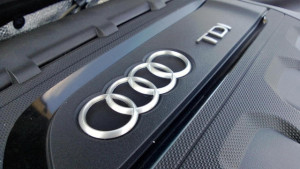
The wild card is the pending TDI diesel engine that Audi has on deck for fall (or spring 2015). There has been no official statement yet about mileage – or performance. But Audi has a well-deserved rep for building diesels that are both very strong and very efficient. To whet your appetite for what may be coming, consider the diesel V-6 in the current A6. It produces 240 hp and 428 ft.-lbs. of torque, gets the car to 60 in 5.5 seconds – and still manages 38 MPG on the highway. The A3’s diesel will be a four – and this smaller engine ought to deliver at least 38 highway in the smaller (and much lighter) A3. I would not be surprised to find the soon-to-be-here diesel will ring the 45 MPG bell. And that would be bad news for both Mercedes (no diesel in the CLA) and make things even-Steven with BMW (which currently offers a 45 MPG-capable diesel in the 3 Series sedan).
Audi has done a two-step here that’s pretty clever in terms of splitting the difference between the Benz CLA and the BMW 320i.
You can stick with the base 1.8 engine and match the acceleration potential of the more expensive 320i – negating that model’s slight advantage at the pump. Or, you can opt for the 2.0 engine – and watch the Benz CLA disappear in your rearview (assuming it’s not an AMG Benz).
Either of the Audi’s two available gas engines is a good choice. Your choice comes down to good – or very good – acceleration. The turbo boost is seamless – without lags or sudden spikes of power – and the torque spread (258 ft.-lbs. in the 2.0) covers the RPM range, from just above idle to the appx. 6,400 RPM redline. It’s fun to wind the little turbo four to redline, but it’s not necessary. This is what separates modern turbo fours from the fours (turbocharged and not) of the past. They don’t behave like fours – turbocharged or not. In the past, fours were either underpowered, or (if turbocharged) the power came on unevenly. You’d mash the gas and nothing would happen . . . or something startling would happen. The turbo would spool up and the engine would react like a sleeping cat whose tail just got stepped on. The A3’s turbo fours – both of them – respond more like larger sixes without turbos, which is just what’s wanted for an everyday car that has to swim in heavy traffic, where “right now” power is needed and bogs (and sudden bursts of turbocharged fury) aren’t.
It’s just a shame that Audi doesn’t offer you the choice of a manual or automatic transmission. A stickshift option – especially if offered with the less powerful 1.8 liter engine – would make for an interesting counterpoint to the quicker but less involving-to-drive CLA and the about-as-quick, manual available and fun-to-drive – but nearly $3k more costly – BMW 320i.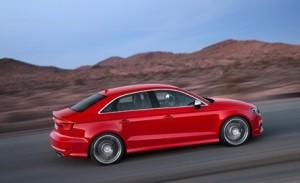
Engine RPM at 70-ish MPH is about 2,200 RPM – not high, but higher than in cars with seven and eight speed automatics (CLA and 320i, respectively). Probably, the A3’s fuel economy numbers would be higher, too, if the car had an eight speed automatic (as in the A4 and A6) rather than a six-speed automatic.
Compared with the CLA, the A3 has fairly thick “A” and “B” pillars – along with a rearward view limited by a fairly small aperture back glass made functionally smaller by the intrusive presence of tall second row headrests that eat up probably 20 percent of the available view on either side. This is not Audi’s fault, though. The federal government has mandated these “tall boy” headrests as an anti-whiplash countermeasure and you’ll find them in virtually every new car, regardless of price point. However, the situation is made worse by the small back glass – and also by the smallish, oval-shaped rearview mirror.
However, the upright seating position, relatively low door tops and generous side glass compensate some for the blindspot blues.
An interesting feature is the Efficiency Program that lets you monitor how many gallons of gas per hour running the AC and other accessories is costing you. During a weeklong test-drive of an A3 2.0 Quattro, I averaged 25.5 MPG, according to the car’s computer. This is only slightly less than the EPA’s 27 MPG “combined” number – and you’ll probably do better because I probably drive faster (and harder) than you do.
The A3 is a very space-efficient car. Though it is smaller than both the Mercedes CLA and the BMW 3 (182.3 inches and 182.5 inches, respectively, vs. 175.4 inches for the Audi) it has a much roomier back seat than the Mercedes (27.1 inches) and exactly as much room in the back seat (35.1 inches) as the bigger-on-the-outside BMW. Front seat legroom is not sacrificed to achieve this, either. In fact, the A3’s 41.2 inches of front seat legroom is an inch more legroom than in the Benz CLA (40.2 inches) and only a negligible amount less than in the takes-up-more-room-in-your-garage BMW 3 (42 inches).
Headroom in the Audi is also generous – and more balanced. Up front, there’s 36.5 inches and in the second row (where there’s often less in other cars) there’s still 36.1 inches. The Mercedes has more headroom for the driver and front seat passenger (38.2 inches) but the backseat passengers – already tucked in the fetal position on account of the dearth of legroom – must also duck due to the lack of headroom – just 35.6 inches. The BMW – which has a more formal posture than the Benz – is better in this regard, with 40.3 inches of front seat headroom and 37.7 inches for the backseat riders. But, it should be so – given it’s almost a mid-sized car while the Audi is a compact-sized car. Yet the much smaller on the outside Audi gives you almost the same space inside as the BMW – and much more space inside than the beautifully styled but functionally compromised Mercedes.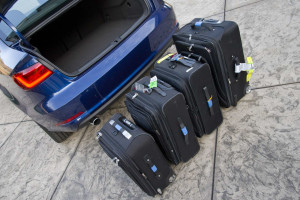
The one real estate-related category where the A3 earns its “compact car” classification is trunk space. There isn’t much. Just 10 cubic feet – vs. 13 cubes on the BMW 3 and 13.1 in the Benz.
Styling-wise, the A3 is not as dramatic-looking as the Benz CLA but that can be an asset or a liability, depending on what you’re after. Some may see the Mercedes as trying too hard to look high-dollar while the Audi seems perhaps more comfortable in its shoes. Like the A4 (or even the A6) just with a smaller footprint.
Speaking of which: Though the A4 is nearly 10 inches longer overall than the A3, the interior dimensions of these two Audis are virtually identical: 41.3 inches of front seat legroom and 35.2 inches in the back for the A4 vs. the A3’s 41.2 inches and 35.1 inches. The A3 only comes up short relative to the A4 when it comes to its truncated trunk (10 cubes vs. 12.4 for the A4).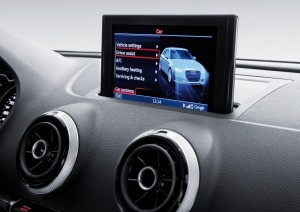
But it’s not just size that matters.
The A3 is also a cut above, features and equipment-wise. It comes standard with an LCD screen that rises elegantly out of the dash (vs. the fixed in place unit in the Benz CLA and the dashboard-mounted display in the BMW 3), standard 10 speaker high-definition audio system with satellite radio, SD card slot, a sunroof, leather (not looks like leather) seats and trim. A larger (and touch-activated) flat screen is optional, as is Wi-Fi connectivity, automated parallel parking, folding outside rearview mirrors and – if you buy the S Line Package – a 14 speaker ultra-premium Bang & Olufsen sound system, LED headlights and additional interior/exterior trim enhancements.
The optional Sport package adds Drive Select adjustable chassis, bolstered sport buckets and paddle shifters. Adaptive cruise control, lane departure warning and collision warning/braking are bundled together in the optional Technology package.
The new A3 (all trims) also comes with the latest version of Audi’s Multi-Media Interface (MMI) interface, which has been simplified – thank god. It is no longer necessary to do the two-step – first push a button then turn a knob – if you want to raise or lower the fan speed, or adjust the temperature settings. Just turn the knob .The seat heater settings (part of the Cold Weather Package) have been similar streamlined.
There are four main buttons on the center console for the audio, navigation, media and phone systems. Push to select, then use the large center mounted dial to scroll to what you want.
I really like the A3’s ball-type air outlets. They look sporty and they’re infinitely more adjustable than the usual/typical “box” type that have more limited adjustment potential.
One thing I did not like was the A3’s upholders, which are mounted so far forward on the center console that your beverages have to be tilted slightly forward to get them into the holders – and then again on the way out. This can lead to spillage – on the console and on you. The source of the problem is the console mounted gear selector, which eats up a great deal of space. Given that this car is (in the U.S.) automatic-only, why not just do as Mercedes has done in the CLA and use a column-mounted toggle shifter (with paddle shifters on the steering wheel for manual mode) instead? A console-mounted shifter in an automatic-only car is an affectation that serves no functional purpose.
THE REST
This is a “Goldilocks” car. Like the porridge in the story, it’s just right. Not too big on the outside, but not too small on the inside. Better performance than its price-equivalent rivals. Probably better mileage, too. Or at least, better mileage at lower cost. The diesel version of BMW’s 3 Series starts at $38,600 – almost $10k more than the base A4. It is highly not likely that Audi will charge close to $40k for the soon-to-here diesel powered A3.
If Audi offered a manual transmission (they do in Europe) or at least gave the A3 the eight-speed automatic it deserves, it’d be the Total Package.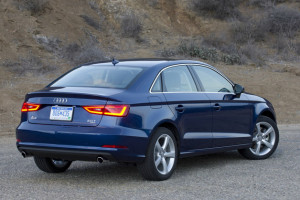
THE BOTTOM LINE
This is a little car that’s big on space – and value – while giving up nothing as a premium car.
Audi’s biggest problem may be that the A3 will bleed sales away from the A4 as much as it will appeal to buyers cross-shopping the Benz CLA and BMW 3.
Throw it in the Woods?
Spread it via Twitter: LibertarianCarG (they would not let me have “guy”).
And:
We depend on you to keep the wheels turning. If you value alternatives to the MSM, please support independent media. Our donate button is here.
For those not Pay Pal-inclined, you can mail us at the following:
EPautos
721 Hummingbird Lane SE
Copper Hill, VA 24079







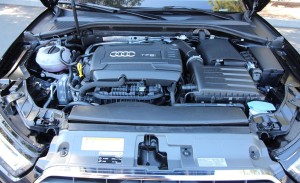


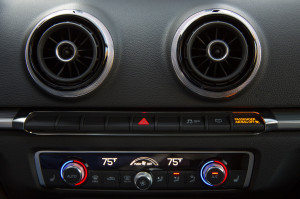






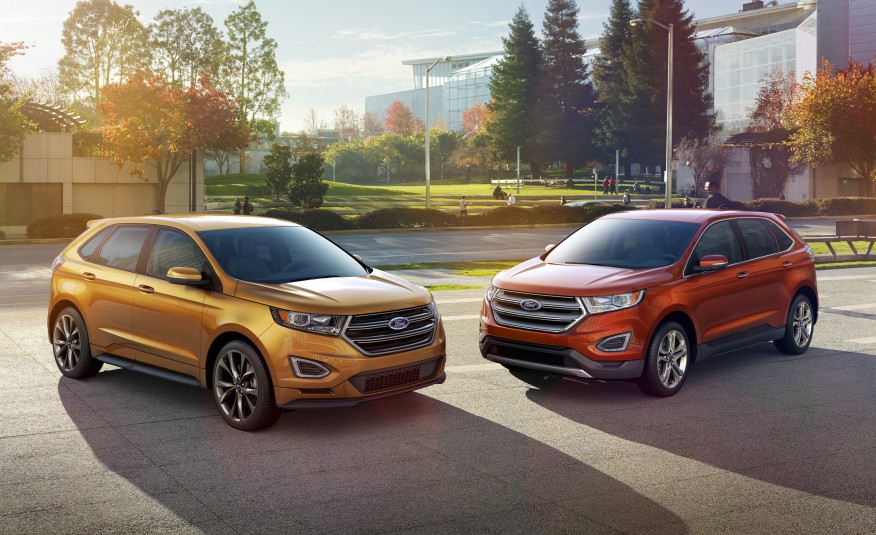
Last week, I took delivery of an A3 Sportback 2,0 TDI – a much more practical version of the 8V chassis. A personal opinion because I don’t know why anyone would purchase an A4 or A6 sedan over an Avant either. Fortunately, I was able to order the car the way I wanted and not be stuck with the stuff Audi America has decided is good for you – such as a sunroof, automated parallel parking or lane departure warning. The dealer even replaced the passenger-side sunvisor (which thanks to the EU Mafia had airbag warnings and instructions) with a clean black one.
In Germany, the Smoker’s Packet is extra. If one chooses this phallic symbol option, one of the two cupholders secures an ashtray (which also looks a lot like a cup with a lid). The other is still impractical but Germans have a difficult time understanding why anyone would drink and drive. Most have driven in other Countries and will tell you they `get´ why cupholders are useful in France, Italy, etc. but they don’t seem to `get it´ enough to bother with them much.
I think, the headrests you complain about are also a US thing. The headrests here sit only a few centimeters above the top of the back seat. If a passenger is sitting there, he can pull it up higher. It really makes no difference then because even if there were no headrest, his head would be blocking the rearward view anyway.
I have that same small, oval rear-view mirror but it is not a problem because the driver’s mirror glass is aspheric meaning, there is no “blind spot”. These are illegal in the States do to government mandate so to help with this, some manufacturers fit larger inside rear-view mirrors and offer expensive “blind spot” cameras.
One thing I hate about the US/Canadian Audi’s is their absolutely shit tail-lights. For a company bragging about safety, they should fit the same lights they have for Europe and not the all-red, brake-light-used-for-turn-signal turds they put on all their North American cars.
Also, the 180PS front drive A3 here comes with an optional 7 speed DSG and the Quattro version has an optional 6 speed DSG – they also weigh 20Kg more than the standard transmission cars. The 8 speed automatic (not DSG) is fitted only in the A6 Hybrid or the most powerful 3,0 liter Diesel Quattro.
Funny, I just spent a week camping in my 2012 A3 TDI (sport back). Much more practical and useful than the sedan. I guess that’s why it won’t come to the American market, we have no use for such things.
I know, Eric… I know.
For whatever Weird reason, the American market does not like high-end hatchbacks/wagons… but I sure do!